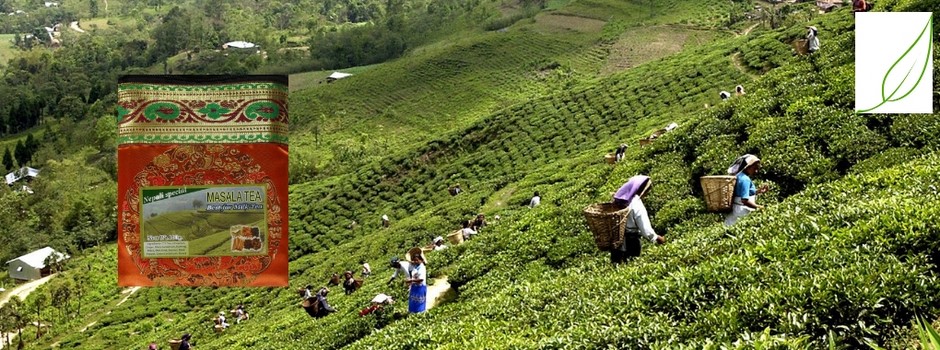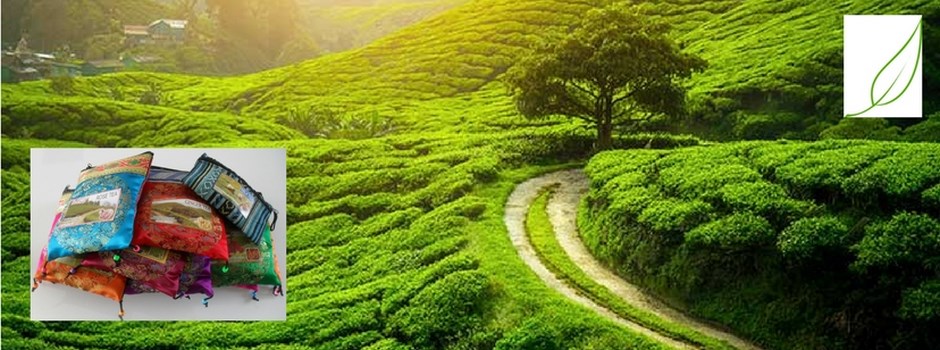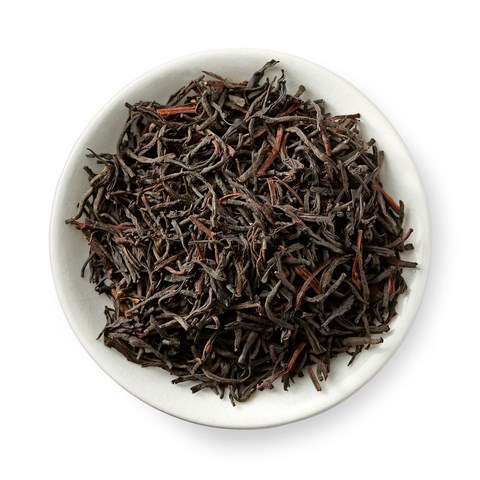The culture of the tea
All types of teas are originally from the same tree and its leaves: the tea plant (Camellia sinensis). What's setting the different varieties of tea will depend on the following :
the gardens of origin.
the type of practiced picking and harvest period.
the different treatments that will receive the sheets during the manufacturing process.
know-how.
There are three types of collection:
- Imperial picking : she is to pick only the terminal bud called "PEKOE" (Chinese PAK-HO meaning "fuzz") as well as the closest of the Pekoe sheet. This collection once reserved for emperors remains limited because of its cost.
- Fine picking : it is to harvest the terminal bud and two leaves that are closest to him.
- The classic picking : it is to harvest the terminal bud mature and three or four leaves that are closest to him.
Although the manufacturing steps differ from tea to another and according to the regions, we can identify 6 main stages in the production process of tea: picking, the withering, rolling, oxidation, drying, sieving - sorting - packaging.
Phase 1: the gathering
According to a precise timetable, the collection has an important influence on tea. According to region of origin, the altitude of the garden, know-how of farmers, the choice of the leaves that are levied or the amount of present buds, each harvest will give rise to different teas. The theory claims that is picked on the tea as the youngest leaves at the end of each twig turned to the Sun. The tea plants are trimmed to obtain in real tables of picking to make less experiencing the work of harvesters but also to ensure that the best quality and to give to the tea plant performance, robustness and longevity increased.
Harvested tea is then thrown into a basket that contains about 7 to 10 kg of fresh tea (which equals 1 to 1.5 kg of manufactured tea).
Picking is probably the most delicate operation in the culture and manufacture of tea. The general principle of quality is that, more the picked leaves are close to the terminal, best bud will be the quality, both in terms of the richness of the components of tea taste. Indeed, it is at the end of the shrub that SAP is the most concentrated: the flavor will be only more subtle.
Phase 2: the withering
The goal of this step is to make the softer (more malleable to stage tea leaf
driving) and to make him lose much of its moisture. During this stage, the leaves
who are in contact with oxygen, will begin their process of oxidation.
For black teas (Nepal, India), the leaves are spread out evenly on a grid and are put in contact air. The air temperature, humidity, ventilation and the duration of withering are rigorously monitored. The withering lasts about 13 hours.
For the Teas, Oolong (China, Taiwan), the leaves are spread out on large canvases, in the open air.
For green teas (Nepal, India, China), the leaves after harvest, are quickly sent to the factory and are generally not wilting.
The goal is to keep these leaves in their original state, without oxidation.
They spend directly on the rolling stage.
For white teas: this is not oxidized teas. Tea underwent two operations wilting and drying immediately, these two being most of the time in the open air.
Phase 3: rolling
Taxiing is to roll the leaves on themselves in the sense of the length in order to shape them and bring out the juices and essential oils. For black tea, the objective is a little different. Sought here to break the cells of the tea leaves in order to facilitate their oxidation.
Phase 4: oxidation
It is during this stage that will prove the astringency (or bitterness) tea, flavor, body
and the color of the liquor. In contact with the oxygen in the air, the leaves previously 'prepared ' during the stage of rolling, are laid to rest in a warm and humid atmosphere. This will encourage the chemical phenomenon so-called 'enzymatic oxidation' and oxidized tea leaves. This is not a process of fermentation.
Phase 5: desiccation
The purpose of this step is to stop the oxidation process. For this, we will heat (still wet) leaves on a high, "brutal" way, to dry. This intense drying will then destroy the enzyme responsible for oxidation. The drying time and the used temperature are paramount.
For black teas (Nepal, India), the leaves are dried in heated cylindrical tanks
at a temperature of 120 degrees for 20 to 30 minutes.
For teas Oolong (China, Taiwan), the procedure is the same but the temperature is brought to 300 degrees for a very short time.
For green teas (Nepal, India, China), the leaves are dried in steam for a period ranging from 20 to 80 seconds.
Phase 6: sieving, sorting and packaging
In these final steps, the leaves are dimmed to get rid of dust and rods then they are sorted according to their caliber. These operations are performed mechanically using machines or manually.
Then the leaves are packed according to different methods with a specific purpose, which is to protect the tea of any humidification.
Note that in some cases, a final drying can be done before packing to homogenize the different sheets from lots and 'wake up' their aromas.
Grades of tea
For black teas from India and those from countries that have undergone English influence, the quality grades of black teas are designated by acronyms. Overall, the more letters there are, the more it means a quality tea. This classification is thus found for teas from Sri Lanka (Ceylon), Nepal, Bangladesh, Turkey, Georgia, Iran, and other countries in Africa and South America. Finally, only Chinese and Japanese teas do not meet this classification. The terminal bud is called tip or Pekoe, deriving from a Chinese word meaning "down". When rolling, the leaf juice will impregnate the tips, giving it a golden or silver color, hence the terms golden and silver. The term orange means "royal", by reference to the royal family of the Netherlands, the Orange-Nassau.
Whole leaves
We find in ascending order of quality:
- Chong: Very large leaves, low on the tea (4-5e), wide and old, used to prepare Chinese smoked teas;
- Pekoe: Finer leaves, without buds, coarse appearance;
- FP (Flowery Pekoe): Rolled leaves in a ball.
- OP (Orange Pekoe): Young leaves (late fine picking);
- FOP (Flowery Orange Pekoe): Bud and two last leaves ("Imperial" collection). The buds gild with fermentation, and are sometimes called Golden tips ("golden spikes").
The classification of this latter category is finer in North India and Nepal, and accounts for the relative amount of buds and their quality. We find in ascending order of quality:
- GFOP (Golden Flowery Orange Pekoe): Tea rich in golden buds;
- TGFOP (Tippy Golden Flowery Orange Pekoe): contains only buds;
- TGFOP 1 (tippy Golden Flowery Orange Pekoe one): High quality TGFOP tea;
- FTGFOP (Finest tippy Golden Flower Orange Pekoe): High quality TGFOP tea;
- FTGFOP1 (Finest tippy Golden Flower Orange Pekoe One): idem, better;
- SFTGFOP (Special finest tippy Golden Flower Orange Pekoe): exceptional quality FTGFOP tea;
- SFTGFOP 1 (Special finest tippy Golden Flower Orange Pekoe One): idem, in better.
Broken leaves
The leaves are no longer whole and much smaller than in an orange Pekoe. The drink is more full-bodied and darker, and the shorter infusion. The grades equivalent to those of whole-leaf teas are found in ascending order, with the letter "B" for Broken (broken):
- bp-Chong: Coarse low-quality pickup;
- BP (broken Pekoe): Lower leaves (2-3e) not containing buds;
- Bop (broken Orange Pekoe);
- FBOP (Flowery Bop);
- GBOP (Golden Bop);
- GFBOP (golden flowery bop);
- TGBOP (Tippy Golden Bop).
Crushed leaves
Teas whose leaves are crushed before the end of the Oxydation1 are found in the Fujian region of China. There are mainly two kinds of crushed leaf teas:
- F (Fanning): small pieces of leaves used in tea bags;
- D (Dust): The leaves are practically reduced to powder but are not used in tea bags. This type of use is not a grade of tea.
Other teas
The other colors of teas do not have an international system of rank comparable to that of black tea.














